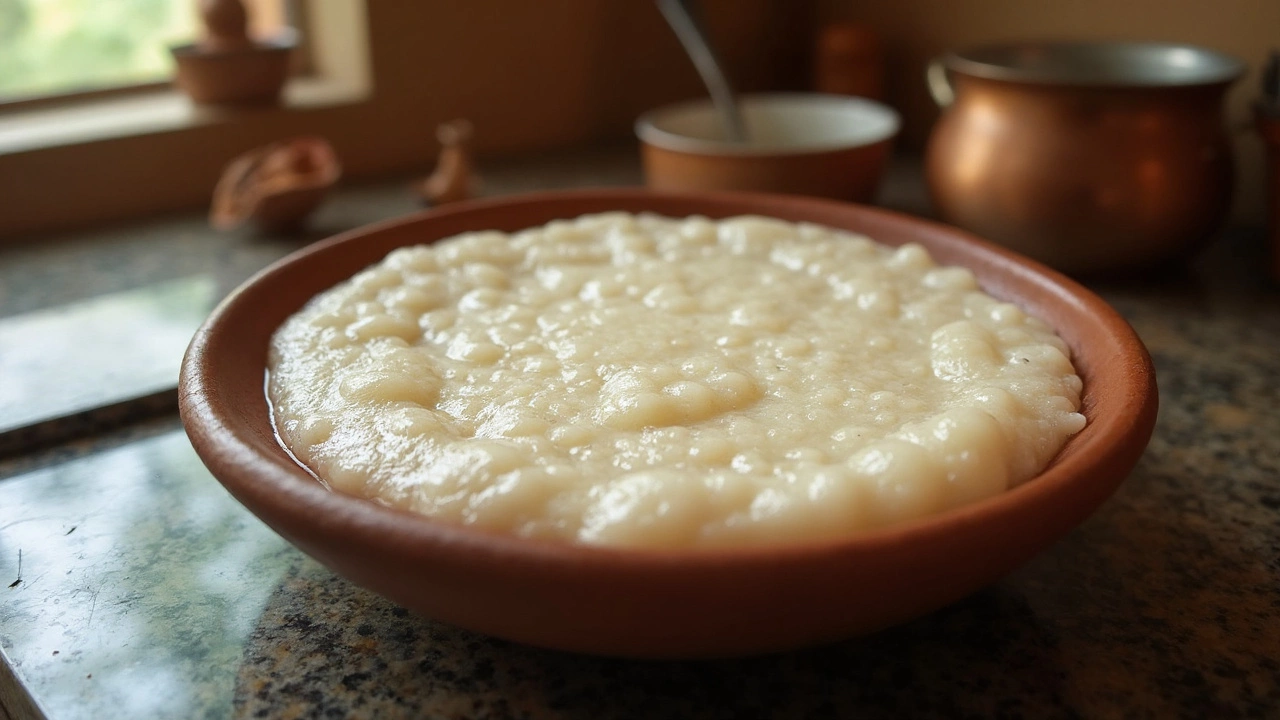Speedy Fermentation: Dosa Batter Without Yeast
 Feb, 15 2025
Feb, 15 2025
Struggling to ferment your dosa batter quickly without yeast? You're not alone. It's a common quest for many dosa lovers, and the good news is—there are ways to speed up the process without compromising taste or texture!
First, let's talk about the basics. Fermentation isn't as complicated as it seems. Essentially, you're looking to create an environment where natural bacteria thrive and work their magic on the rice and urad dal mixture. Traditionally, this process can take anywhere from 8 to 12 hours, which feels like an eternity when you're hungry for dosas.
One of the easiest ways to give a nudge to the fermentation process is temperature control. Did you know that warm environments boost fermentation? If it's winter or just chilly, try placing the batter in the oven with just the light on or near a warm appliance. It can make a significant difference.
- Understanding Fermentation Basics
- Ideal Ingredients and Ratios
- Optimizing Soaking Time
- Smart Grinding Techniques
- Creating the Perfect Environment
- Alternative Methods to Speed Up Fermentation
Understanding Fermentation Basics
Fermentation might sound intimidating, but it's actually a pretty straightforward biological process. At its core, fermentation involves breaking down sugars by bacteria and yeast. In the case of fermenting dosa batter, we're relying on naturally occurring wild yeasts and lactobacilli.
So, why ferment? Well, this process not only improves the flavor of the batter, giving it that distinct tangy taste we love in dosas, but also increases its nutritional value. Fermentation enhances digestibility and availability of nutrients like B vitamins and vitamin C.
Temperature is Key
Temperature plays a crucial role in fermentation. Wild yeast and bacteria are more active at warm temperatures, around 30°C to 35°C, which is why fermenting during the Indian summer is often faster. When temperatures drop, you might need to get creative, like using that nifty oven light trick we mentioned earlier.
Role of Ingredients
Choosing the right ingredients in the right proportions is where the magic begins. Typically, a dosa recipe calls for a 4:1 ratio of white rice to urad dal. This ratio ensures enough carbohydrates are available for those microbes to munch on, alongside proteins from urad dal to support the process.
Tools of the Trade
- Mixie or Grinder: A good quality grinder can make all the difference. It breaks down rice and dal effectively, offering more surface area for bacteria to do their work.
- Container: Use a big enough container to allow for expansion, at least twice the volume of the batter.
By understanding these simple basics, you set the stage for a quick and effective fermentation, even without yeast. Remember, patience and a bit of warmth can bring out the best in your batter!
Ideal Ingredients and Ratios
When it comes to making the perfect dosa batter, the right ingredients and ratios can make all the difference. You'll often find that achieving the best results starts with understanding what goes into your batter.
Basic Ingredients
The essentials for a classic dosa batter are pretty straightforward:
- Rice: Typically, a combination of regular rice and parboiled rice is used. A common mix is 3 parts regular rice to 1 part parboiled rice. This combo gives the dosa its crispiness.
- Urad Dal: This lentil is key for fermentation. Generally, you'd use about 1 part urad dal to every 3 parts of rice. The dal helps in creating that magical fluffiness and slight tang in your dosas.
- Fenugreek Seeds: A small amount, say around a teaspoon for every cup of dal, does wonders. It enhances the fermentation process and adds that unique flavor.
Water and Consistency
Getting the right consistency is crucial. Too thick or thin, and your dosas won't quite hit the mark. When grinding, aim for a smooth but slightly grainy paste. Use enough water to achieve a batter that coats the back of a spoon without being runny.
Adjusting for Texture
If you're new to dosa-making, it might take a little practice to nail down the exact texture you're aiming for. Here are a few adjustments you can play with:
- If the dosa turns out too chewy, try tweaking the rice-to-dal ratio by increasing the rice.
- For an even crispier dosa, use more parboiled rice.
Example Ratios
To give you a clear picture, here's a basic ratio guide that many swear by:
| Ingredient | Ratio |
|---|---|
| Regular Rice | 3 |
| Parboiled Rice | 1 |
| Urad Dal | 1 |
| Fenugreek Seeds | 0.25 |
Play around with these ratios a bit to discover what works best for your taste and texture preferences. And there you have it—the building blocks to a ferment dosa batter that hits the spot every time!
Optimizing Soaking Time
You can't rush perfection, but with dosa batter, you can definitely cut some corners without losing quality. Let's chat about optimizing the soaking time for your ferment dosa batter.
Typically, rice and urad dal need to be soaked separately for at least 4 to 6 hours. This rule isn't just a suggestion—it's crucial to get the softness and volume you're aiming for. But here's a little trick: using lukewarm water can actually reduce the soaking time. Yep, you heard that right! Lukewarm water starts breaking down the grains quicker and gives fermentation a kickstart even before you've ground the batter.
Master the Ratio
For a faster and more efficient soak, always stick to the 2:1 or 3:1 ratio of rice to urad dal. This balance makes sure your batter is light and fluffy. An excess of either could slow things down.
Once soaked, drain and rinse your ingredients thoroughly. Why? Rinsing multiple times removes extra starch and impurities, ensuring a cleaner batter that's easier to ferment.
Sprinkle in Some Fenugreek
Fenugreek seeds are like the secret chefs behind the scenes. Adding just a tablespoon to the urad dal soak not only adds flavor but can also promote a faster fermentation. These little seeds are powerhouses that introduce natural sugars to the mix, which the bacteria love.
Here's a quick checklist to optimize soaking:
- Use lukewarm water for faster soaking.
- Stick to the ideal rice-to-urad dal ratio.
- Rinse grains well to remove impurities.
- Add a tablespoon of fenugreek to the dal soak.
By optimizing your soaking time with these strategies, you're setting a solid foundation for a quicker fermentation process. So, go ahead, treat the grains right, and watch how it transforms your dosa game!

Smart Grinding Techniques
Getting the grind right is half the battle won when it comes to perfecting your dosa recipe. Believe it or not, the consistency of your batter can seriously influence how well it ferments. So, let's dig into some smart grinding hacks!
Using the Right Equipment
First things first, a high-quality wet grinder is worth its weight in gold. While blenders and food processors are convenient, a wet grinder is designed to deliver the right texture for fermenting dosa batter. The stones in a wet grinder crush and grind more evenly compared to the blades in a blender. If you’re an avid dosa-maker, this could be an investment worth considering.
Mastering the Consistency
A silky-smooth batter with a slight consistency between pancake batter and ketchup is your goal. Too thick, and it takes longer to ferment. Too runny, and you might not get that perfect crispiness. A good tip is to reserve a little of the soaking water and gradually add it during grinding until you hit the sweet spot.
Sequential Grinding
Grinding the urad dal and the rice separately can elevate the end-product. Urad dal should be ground to a fluffy, light consistency—this is the base that helps trap air and causes the batter to rise. The rice, on the other hand, should be ground to a slightly grainy paste. Combining both masterpieces gives you a batter that's prepped for successful fermentation.
| Component | Optimal Grinding Time |
|---|---|
| Urad Dal | 15-20 mins |
| Rice | 30-35 mins |
Timing The Grind
Patience during grinding pays off! Rushing through this part can result in a gritty mixture that might not ferment properly. Keep an eye on the clock and ensure you don't skip any steps. A little patience can lead to a batter that ferments quicker and rises better.
Ultimately, having a good grind is a tactical advantage. It doesn't just help the fermenting dosa batter; it also contributes immensely to the crisp and fluffy dosas we all crave. So, give it the attention it deserves!
Creating the Perfect Environment
Getting the right environment for fermenting dosa batter is like setting the stage for a great performance. The ideal conditions make all the difference in speeding up the process without relying on yeast.
Temperature Matters
Warm temperatures are your best friend here. Aim for a cozy spot in your kitchen that's around 25 to 30 degrees Celsius. If your kitchen is too cool, turn on your oven light and place the batter inside, or wrap the container in a towel to minimize heat loss.
Container Choice
The type of container you're using plays a crucial role. Opt for a large enough bowl to allow the batter room to expand. Using a ceramic or glass container can also help maintain warmth better than metal.
Covering Techniques
Cover the batter with a breathable cloth rather than an airtight lid. This prevents unwanted condensation and allows natural air exposure, essential for promoting fermentation.
Monitor and Adjust
Keep an eye on your batter, especially during its initial hours. If it hasn't risen due to a cooler-than-expected kitchen, don't hesitate to move it to a slightly warmer spot.
| Factor | Recommended Action |
|---|---|
| Temperature | Keep at 25-30°C |
| Container | Use ceramic or glass |
| Covering | Use breathable cloth |
Creating this perfect environment doesn't require any high-tech equipment or fancy tricks, just a few thoughtful adjustments. By mastering these simple changes, you can enjoy a quick and effective fermentation process, bringing you one step closer to biting into a delicious dosa.
Alternative Methods to Speed Up Fermentation
In the quest to ferment dosa batter faster, there are multiple methods to explore. If waiting isn't your strong suit, these strategies can reduce the time without needing yeast.
Natural Boosters
Let's talk boosters. Ever thought about using a pinch of sugar or fenugreek seeds? These ingredients don't just add flavor; they can kickstart the fermentation process. The sugars feed the bacteria in your batter, helping them multiply faster.
Sourness to the Rescue
This might sound odd, but adding a spoonful of sour curd can be a game-changer. The lactic acid bacteria in the curd introduce more cultures to the batter, speeding things up significantly.
Pro Tips for Quick Fermentation
- Warm Water Usage: Mix your batter with warm water instead of cold. It gives an instant head start.
- Pre-soaked Grains: Soaking rice and dal in warm water can also activate the natural cultures early.
- Grinding Techniques: Grinding the mixture in small batches can help maintain the batter at a warmer temperature.
Some dosa enthusiasts suggest using a pressure cooker as an incubator. Just add a bit of hot water at the base, place your batter bowl inside, and cover it (not under pressure, though). This small incubator environment can keep your batter cozy, allowing it to rise faster.
And if you're a numbers person, here's a stat for you: by optimizing these alternative methods, some have seen fermentation times cut by 30% or more! Just imagine, those crispy dosas could be ready in a fraction of the time you're used to.